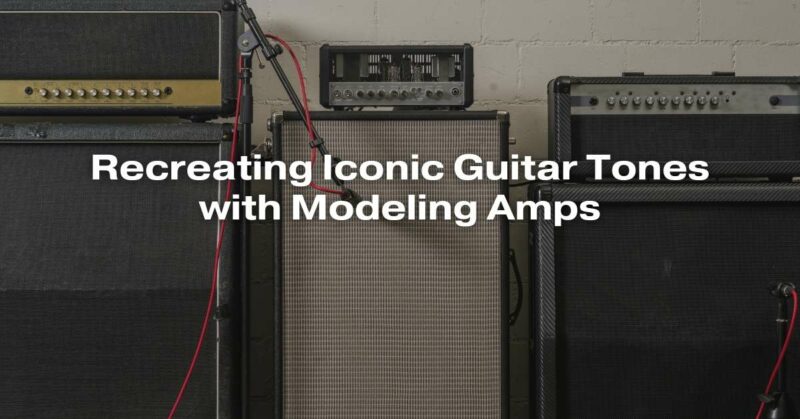The quest for iconic guitar tones has been a lifelong pursuit for many guitarists. From the legendary tones of Jimi Hendrix’s fuzz-soaked solos to the crystalline clean tones of David Gilmour, these iconic sounds have left an indelible mark on the world of music. While achieving these tones once required an extensive collection of vintage amplifiers and effects pedals, the advent of modeling amps has revolutionized the way guitarists can recreate these iconic tones. In this article, we’ll delve into the world of modeling amps and explore how they enable guitarists to replicate some of the most legendary guitar tones in history.
What are Modeling Amps?
Modeling amps are a relatively recent innovation in the world of guitar amplification. They are designed to emulate the sounds of classic amplifiers, speaker cabinets, and effects pedals using digital signal processing (DSP) technology. These amps can simulate a wide range of tones, from vintage classics to modern high-gain monsters, all within a single unit. Modeling amps have gained popularity due to their versatility, cost-effectiveness, and the convenience they offer to guitarists who want to explore various tones without the need for an extensive gear collection.
Recreating Iconic Tones
Modeling amps have opened up a world of possibilities for guitarists looking to recreate iconic tones. Here’s how they do it:
- Amplifier Emulation: Modeling amps accurately replicate the sonic characteristics of famous amplifiers. Whether you’re chasing the creamy overdrive of a vintage Fender Deluxe Reverb or the raw power of a Marshall Plexi, modeling amps can emulate these iconic amps with precision. They meticulously recreate the amp’s circuitry, tonal characteristics, and even the way it responds to your playing dynamics.
- Cabinet Simulation: The speaker cabinet is a crucial component of a guitar’s tone. Modeling amps include cabinet simulation technology that allows you to choose from a variety of virtual speaker cabinets. This lets you match the amplifier emulation with an appropriate cabinet, whether you want the warmth of a vintage 4×12″ or the clarity of a 1×12″ combo.
- Effects Integration: Many iconic guitar tones are defined by the use of effects pedals. Modeling amps come equipped with a vast array of built-in effects, such as reverb, delay, modulation, and distortion. You can dial in these effects to recreate the specific sounds used by your favorite guitar heroes. Additionally, many modeling amps allow you to chain effects together in any order you like, just like a pedalboard.
- Presets: Modeling amps often include presets that are designed to replicate famous guitar tones. These presets can be a great starting point for dialing in iconic sounds and serve as a foundation for further tweaking to match your personal preferences.
Examples of Iconic Tones and How to Achieve Them
Let’s take a look at a few iconic guitar tones and how modeling amps can help you recreate them:
- Jimi Hendrix’s Fuzz-Drenched Psychedelia: To emulate Hendrix’s iconic fuzz tones, select a modeling amp with vintage Fender amp and speaker cabinet simulations. Add a fuzz effect, crank up the gain, and experiment with different pickup positions on your guitar for that signature “Purple Haze” sound.
- David Gilmour’s Ethereal Clean Tones: Gilmour’s clean tones are renowned for their clarity and spaciousness. Start with a clean amp model and add subtle modulation effects like chorus and a touch of reverb. Experiment with your guitar’s tone and volume knobs to find the sweet spot for those soaring leads and clean arpeggios.
- Eddie Van Halen’s Brown Sound: Eddie Van Halen’s “Brown Sound” is synonymous with high-gain, harmonically rich distortion. Choose a modeling amp with a classic British amp model, crank up the gain, and add a phaser effect to capture the essence of Van Halen’s iconic tones.
Conclusion
Modeling amps have ushered in a new era of convenience and affordability for guitarists seeking to recreate iconic tones. While nothing can fully replace the magic of vintage gear, modeling amps come remarkably close, offering a plethora of options for crafting your desired sound. Whether you’re a classic rock enthusiast or a modern metal shredder, modeling amps provide the tools to explore, experiment, and create iconic guitar tones without breaking the bank or hauling a massive rig. So, plug in, dial up your favorite legendary tone, and start making music history of your own.


